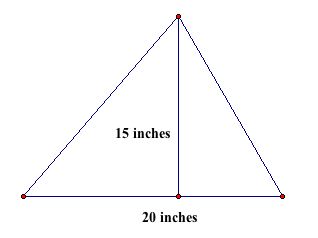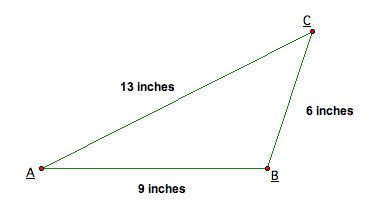
6690 - Using Computers in Mathematics Instruction
Danie Brink
To determine the area of a triangle with a base with length 20 inches and a perpendicular height of 15 inches, we calculate the area as follows:
Area = 1/2 base multiplied by height = (0.5)(20)(15) = 150 square inches. |
 |
To determine the area of a triangle with side lengths 6 inches, 9 inches and 13 inches, we first need to calculate the size of one of the angles of the triangle.
Let us determine the size of angle A first. The cosine formula tells us that: cosA = (6^2-9^2-13^2) / (-2)(9)(13) = 23.9 degrees. Now we can use the area rule and determine the area for the triangle: A = 0.5(13)(9)(sin23.9 degrees) = 23.7 square inches. |
 |
To determine the area of this triangle using Heron's formula is quite a lot simpler.
Area = sqrt [(s)(s-a)(s-b)(s-c)] with s = [a+b+c]/2 =sqrt [((9+13+6)/2)(14-13)(14-9)(16-6)] =23.7 square inches |
 |
Link to the Heron's Formula Page
Link to my 6680 Main Page
Link to my 6690 Main Page